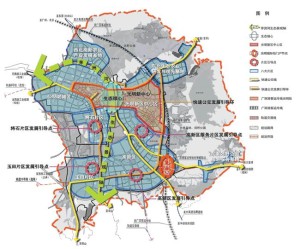
Guangming New District is one of the seven districts of Shenzhen City in Guangdong Province. Located in the northwest of Shenzhen in Bao’an district, the total planned area of Guangming New District occupies 156.1 km², among which 72.33 km² is designated for urbanization (46.33% of the total area). The other 83.77 km² is within the official Basic Ecological Control Line (2005). It currently accommodates about 1 million people.
Since its establishment in 2007, Guangming New District has been developing rapidly, with GDP nearly doubling in the first 3 years. Gunaming New District has been developing as a low-carbon town, and has received three national distinctions for green development: National Green Building Model Town (2008), China’s first low-impact development model town in storm water management (2011), and National Green and Ecological Model District (2013).
Planning Guangming New District
A. The Vision
Guangming New District is envisioned to be a “Green New City, Entrepreneurship New City, and Harmonious New City,” jointly driven by new type of urbanization and industrialization. Guangming New District is dedicated to bringing new regional economical and social development to Shenzhen City, while acting as the major stage for Shenzhen’s economic development and urban construction.
B. The Development Plan
1. Overview of the Master Plan
The new town wants to strengthen its service function towards Hong Kong by creating an environment for innovative technological and research companies, developing a high quality living environment and high quality public facilities, and developing a tourism industry. It aims to use the opportunity of the urbanization process in the northern part of Shenzhen to guide the transformation of its industrial sectors and use the settling of new employments to upgrade the quality of urban life. The intended new industries are low-carbon and high-efficient.
In terms of the deployment of economic sectors, the New Town is divided into three zones. From east to west, these zones are defined as ecological industry development zone, high-tech industry development zone and traditional industry development zone. The ecological zone is suitable for agriculture activities and eco-friendly tourism. The high-tech zone is planned to accommodate companies specialized in flat panel display equipment, new energies, as well as headquarters of small to medium-sized businesses. The traditional zone has been filled with a number of existing manufacturing factories. The main goal is to upgrade them to more advanced modern manufacturing types of industry.
Spatially, the strategies to develop a low-carbon city include a convenient network of public transport and a slow-traffic system, compact and transport-oriented development (TOD) in station areas, introducing greenery from the ecological zone and surroundings by green wedges. It is also planned to adopt a series of green technologies integrated with urban development, such as the use of recycled energies and waste- and rainwater, green building technologies and reducing emissions.
2) “Green Plan” Oriented Development
More than 40 “Green Plans ” have been adopted by Guangming New District. For example, Green New Town Comprehensive Plan, Green Building Specialized Plan, Green New City Construction Plan, etc. Thus the ideas of green industry, green transport, green building, green community, green space, etc are incorporated in the local development.
3) Green Transportation
Low carbon transportation system with separation of cars and pedestrians. Other techniques include the following elements:
- Permeable pavement, bike lane system, PV panels for bus station covers, LED streetlight, etc.
- Slow Transportation System.
- Bus-oriented development strategy, with a bus lane network of 70.8 kms.
- High-efficieny railway system
- Low-impact development in stormwater management.
- High-standard utility tunnel system.
4) Green Building
- Take the green building model projects as an catalyst to promote more construction of green buildings.
- Application of Green building related technology: environmental friendly and recyclable material, solar power lightning system, hot water system, storm water collection, etc.
5) Ecological Infrastructure
- Enhance the construction of ecological parks, and emphasize environmental protection in construction process.
- Vertical green system
- Wetland network
Project Management
Since Guangming New District has now received three national nominations of green development, House and Urban-rural Development is supporting green development related projects. And the administrative system of Shenzhen Guangming New District is is not an independent administrative district as other districts in Shenzhen City. The Guangming New District Committee focuses on economic development, urban construction, social management, etc. At the same time, the functions of social security, land use and regulation, tax, transportation and so on still rely on the representative agencies of Shenzhen City.
Plan implementation
The development of Guangming District is not dedicated to large-scale urban development in a short time period. It has been dedicated to green development so that has explored an untraditional way of new urban development initially started as a traditional industrial zone.Thus the essence of project management in Guangming New District is to incorporate every innovative work and project management into everyday work of the government by setting up green rules. Moreover, it has now become China’s biggest green building demonstration district.